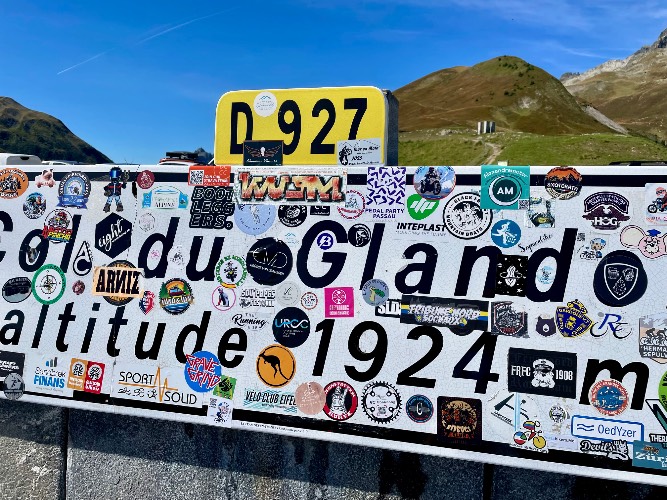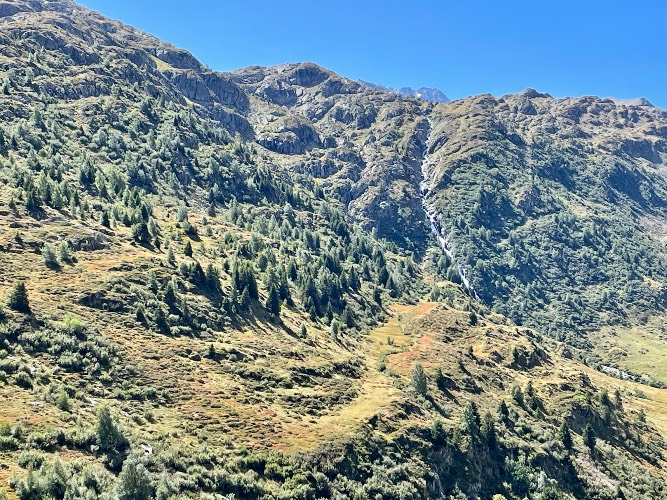![]()
Cycling Col du Glandon from Saint-Étienne-de-Cuines
Ride 19.6 kilometers gaining 1530 meters at 7.4% average grade.
The Col du Glandon is a mountain pass in the French Alps. It links the Maurienne and Oisans valleys, situated in the departments of Savoie and Isère, respectively. The pass stands at an elevation of 1,924 meters (6,312 feet) and provides access to some of the most stunning landscapes in the region.
![]()
Col du Glandon from the east and west completely overlap Col de la Croix de Fer. Both are famed climbs which have been included in the Tour de France many times
![]()
![]()
Here are the basic statistics for the three Croix de Fer climbs, together with the overlap information for Col du Glandon:
- Col du Glandon West (Le Verney): 29 kilometers gaining 1363 meters at 4.1% (5.6% climb only; all overlapping Croix de Fer West).
- Col du Glandon East (Saint-Étienne-de-Cuines): 20.2 kilometers gaining 1,461 meters at 7.3% (all overlapping Croix de fer North).
![]()
The climb has been made famous and included in the Tour de France 14 times between 1947 and 2015 as of 2023.
![]()
The Col du Glandon eastern approach begins in Saint-Étienne-de-Cuines (population 1,208 as of 20202) and is situated in the Maurienne Valley which is in one of the greatest cycling climbing areas of the world (see, PJAMM Cycling Saint Jean de Maurienne Climb Area page).
![Col du Glandon Cycling Col du Glandon - col sign]()
The cycling monument details are slightly different from ours.
The climb passes through several villages over its 20 kilometers until reaching the col at 1,924 m (6,312’). As with nearly all the climbs in this area, the roadway is generally one wide or two narrow lanes but very safe for bike travel.
![]()
The first part of the climb is forested.
Glandon was not included after its first appearance in the TdF in 1947 until 1977 and has been included sparingly thereafter (averaging about once every four years, 11 times in the 43 years between 1977 and 2020). As of 2023, the last time Glandon had been included in the Tour was 2015.
![]()
Keep a sharp eye out - there are several old cement roadway markers along the way.
![]()
We pass through meadows with panoramic views along the climb.
Other amazing and famous climbs in this area are Col du Telegraphe, Col du Galibier, Col du Chaussy (Lacets Montvernier), Col du Madeleine, Col de la Croix de Fer and the Granddaddy of them all, Alpe d’Huez!,
![]()
We pass above the tree line near the top of the climb.
![]()
There are not a lot of hairpins on the climb but we do encounter 4 giant ones just before the Col.
![]()
The road tops out at 1,924 meters. There is a col sign and snack hut at the top.
![]()
Turn left and ride up another 2.5 kilometers to Col de la Croix de Fer.
![]()
After a 300 meters slight descent, climb 2.6 kilometers at 5.7% to Col de la Croix de Fer.
TOUR DE FRANCE
It was on this legendary climb that one of the greatest cyclists of all time, Eddy Merckx, began to accept his decline:
“In the mythology of the Tour de France, he is the romantic hero, a sort of lion-hearted Don Quixote who is spurred on by his grand ideals and aggressive mood swings. Whatever his goals, the climber revels in testing his mettle on the most punishing slopes, and it is this archaic face-off with the high mountains that reveals him in his true splendour. Yet his enduring fascination lies in the fact that he is a rebel at heart, a non-conformist capable of overturning in a single day even the most static hierarchy. It always comes down to the mountain stages. It is there that champions meet their destiny and later, without further delegation, their decline.The greatest climbers accept this rule as the natural, inevitable order of things. Louison Bobet bade the Tour farewell in 1959 from the top of the Col de l’Iseran, the highest pass in the Alps, and the Belgian Eddy Merckx sensed the end was nigh on the Col du Glandon during the 1977 Tour de France where the once-mighty shadow he had cast over cycling had dwindled to a dance of death on wheels” (Philippe Brunel, Born to Climb, The Mountains Made Their Name, Then Swallowed Them Alive, L’Equipe Explore, p. 1) [Emphasis added].
![Col du Glandon - Croix de Fer Cycling Col du Glandon, Col de la Croix de Fer sign, PJAMM cycling, bicycle]()
Merckx realized his mortality on Glandon, Stage 18 1977 TdF.
The king of Col du Glandon is unquestionably Lucien Van Impe (winner 1976 Tour de France). Van Impe participated in each TdF from 1969 to 1981 and Glandon was featured in three of those tours (1977, 1981, and 1983). Van Impe was first across the col on each of those stages, on his way to winning the mountain classification each time.
![Col du Glandon - Croix de Fer Cycling Col du Glandon, Col de la Croix de Fer sign, PJAMM cycling, bicycle]()
Lucien Van Impe, the King of the Mountains, and Col du Glandon
Photo: Philippe B.
Col du Glandon was the prologue to one of the most famous (or rather, infamous?) cycling moments of all time. Col du Glandon was the middle climb of three on Stage 10 July 17, 2001 (Col dd Madeleine, Col du Glandon, Alpe d’Huez). Lance Armstrong had dropped from 5:56 back after Stage 7 to 35:43 back after a disastrous Stage 8 which saw a freak breakaway won by Erik Dekker, Alto Gonzalez, and Servais Knaven. Armstrong was 20:07 back after Stage 9 and his main rival that year, Jan Ullrich, was at 22:41 going into Stage 10.
Armstrong appeared weak on Col de Madeleine which led Ullrich and his Team Telekom to begin an insane sprint up Col du Glandon, leaving Armstrong barely(?) hanging on to the rear of this lead group. However, just a couple kilometers up Alpe d’Huez and with 11 kilometers remaining, Armstrong surged to the front of the group, past Ullrich and then, in a moment of Tour lore, looked back (“The Look”) at Ullrich, fixed his gaze on him momentarily, then put the hammer down and accelerated away from a broken Jan Ullrich to victory and his third Tour de France victory of 7.[1]
![Col du Glandon - Croix de Fer]()
The Look, Alpe d’Huez Stage 10 2001 Tour de France.
Photo from J Barber and F Ruggeri as published in Masculine Heart.
Col du Glandon’s years of inclusion in the Tour de France:
(Wikipedia - Col du Glandon)
[1] We all know, but it is necessary to mention here, that Lance Armstrong’s seven tour victories were all stripped due to the use of PEDs.

 We've partnered with Sherpa-Map.com to bring you the best route planning tool. With a PRO Membership you can use this climb as a reference when creating your route.
We've partnered with Sherpa-Map.com to bring you the best route planning tool. With a PRO Membership you can use this climb as a reference when creating your route. 







